[Editor’s Note: Between late February and early March of this year, Charles Herrick, then unknown to me, appended a set of cogent, knowledgeable, and useful comments to several of photojournalist Ross Baughman’s posts about Capa’s time on Omaha Beach on D-Day. That led me to initiate a correspondence, which in turn prompted him to revisit some research he’d conducted independently on the logistics of D-Day and Capa’s images in relation thereto.
Within a week or so of our first contact, Herrick sent me a carefully written, thoroughly researched, closely reasoned 40-page paper on the subject. I found all of it pertinent to this project, and extremely helpful. At my suggestion, he extracted the self-contained section published here in two parts, starting below; this contains some of the more dramatic of his findings. (Additional portions of his research will appear in a subsequent post.)
Here, for the first time, Herrick identifies the specialty and assignment of the military personnel huddled around the Nazi “hedgehogs” in Capa’s images and the activity they’re engaged in while under fire. I consider it safe to say that no one who has studied and written about these images over the past 70 years has understood what they were seeing. Herrick’s analysis exemplifies what close, careful, informed attention to the specifics of photographs can achieve. Prepare to have your eyes opened. Part 2 appears here; click here for Part 1. — A. D. C.]
•
Valor Reclaimed, Honor Restored:
Combined Demolitions Team 10 on D-Day (continued)
by Charles Herrick
With three of the figures in Capa’s negative 35 arrayed in a spokes-in-a-wagon-wheel arrangement, it seems clear they are concentrating on something. (Click to enlarge.) And it isn’t unreasonable to guess the top figure (1) is observing or even supervising them. But again, what is the subject of their interest?
By enlarging a detail from negative 35, we can uncover additional clues. The first is a curious downward-facing white arc on the front of the helmet worn by Figure 1 (outlined in red). This insignia was a European Theater of Operations (ETO) standard helmet marking, indicating that the wearer was an engineer. We can also see the same crescent on the helmet of Figure 3. Because this second crescent is partially obscured by an object running diagonally in front of it (a rifle?) the symbol may have initially escaped notice, but now that we know what we’re looking at, it becomes fairly obvious. (Click to enlarge.)
So at this point we know for a fact that two of the four figures are demolitions experts, and since they all seem to be focused on the same task, it is not a great leap to conclude that figures 2 and 4 are most likely demolitions experts as well. Given the phase of the invasion (within the first 120 minutes after H-Hour), and a bit of knowledge about the landing plan for the 16th Regiment’s half of Omaha Beach, we can conclude reasonably that these men must belong to the Engineer Special Task Force, which was assigned the mission of clearing lanes through the beach obstacles prior to the first high tide.
Returning to the enlarged detail, we discover evidence to support this theory. Within the three green rectangles can be seen a thin line stretching across the entire photo, and passing through two hedgehog obstacles. There can be only one explanation for this line: it is Primacord, the WWII-era version of this brand of detonation cord. Engineers used Primacord to link multiple charges so they could be detonated simultaneously; this was the standard method employed on D-Day.
The picture now takes on an entirely new aspect. These are not pathetic infantrymen under withering enemy fire, too afraid to move and seeking the inadequate cover of an obstacle. Instead, they are engineers calmly — relatively speaking — going about their dangerous task of clearing obstacles. While they have taken the commonsense precaution of lying down to avoid needless exposure, they are not seeking shelter to any degree that prevents them from doing their job. These are men grimly persevering in the face of enemy fire, not cowering in response to it.
Even a close look at the “corpse” reveals an entirely different story. (Click to enlarge.) He is propped up on his elbows, and his head, though lowered, is not buried in the surf or sand. In fact, he appears to be concentrating on something just below his face. Further, we see what just might be part of the engineer helmet marking; dim, indistinct and partially obscured, but there. Far from being a corpse, it is more likely that this man is alive, unharmed, and in the process of priming the detonation system, while his companions look on. That is, after all, why they came to that stretch of Normandy sand.
Now, turning our focus to the two men working on the pole obstacle in the center background (outlined in orange), we recognize another truth. They are not sheltering behind that obstacle, either. They, too, appear to be combat engineers preparing an obstacle for demolition.
Clearly, then, we see here an organized engineer operation as it performs exactly the task for which it was sent to Normandy. And, now that we know what to look for, the results of their efforts are obvious. Only two seaward obstacles remain standing. The scores of obstacles that should have been there are gone; they’ve already been demolished. The Army’s caption for this image in its official history of the Omaha landings, Omaha Beachhead, 6 June – 13 June 1944, stated, “Landing craft in the background are having trouble in the outer obstacles.” But this is clearly not the case. To the contrary, they have a remarkably obstacle-free run into the beach.
•
It’s now time to get back to Combined Demolitions Team 10. Sixteen of these teams were due to land one minute after H-Hour (0630), followed by six reserve teams and a company of “tankdozers” (tanks modified to function as bulldozers). Each of the sixteen primary teams was tasked with opening a 50-yard-wide breach through the obstacles before the first high tide, three and a half hours later. Choppy seas, strong current, mis-landings and enemy fire conspired to wreck much of this plan. Only six lanes were completely blown, and only two of these — a double lane 100 yards wide – were fully usable, due to loss of marking material for the other lanes.
Remarkably, three of the lanes successfully blown – if we count separately both halves of the double lane – were all blown by the same team. Yes, though tasked to clear just one lane, this team cleared three times as much in the same period. In fact, this one team cleared as many lanes as the remaining 15 demolition teams and six reserve teams combined. And they created the only marked lanes. These heroes comprised Team 10.
Team 10 was scheduled to land on the western half of beach sector Easy Red, but the tide swept them to the eastern half of Easy Red. It was a great stroke of fortune. A lone boat section of infantry had landed in this area and found only light enemy fire, plus helpful cover from smoke. They promptly headed inland. Arriving in the wake of the infantry, Team 10 encountered the same conditions and set to work, relatively unhindered. A half-hour later, another infantry company (Company G, 16th Regiment) landed at this same spot. Leaving some of its men with heavier supporting weapons on the beach to cover its advance, Company G headed inland. With the covering fire of Company G’s weapons, Team 10 continued to enjoy relative freedom of action, though the periodic beaching of larger craft intermittently drew heavier German fire their way.
The eastern half of Easy Red thus became the golden spot of Omaha Beach. Between Team 10’s three lanes and an adjacent lane blown by Team 9, it was the most accessible stretch of beach for the multitude of landing craft milling around offshore. This, coupled with the establishment on Easy Red of one of the first secured routes off the beach, drew following units to this area. Two more companies of the support battalion arrived here, as did the 16th Regiment’s command group. Scattered and mauled units worked their way along the beach and used the route inland, and follow-on units, unable to beach elsewhere, came ashore through Team 10’s breaches, swelling the movement inland.
These advances opened the first two beach exits, breaking the stalemate on Omaha Beach. The site of the penetration onto the bluffs above Team 10’s breaches was so significant that it was later chosen as the permanent location of the Normandy American Cemetery.
As luck would have it, Capa landed on the eastern half of Easy Red, where Team 10 was grimly going about its business. Despite the legend that Capa landed with the first wave, we now know he landed with either Wave 13 or 15, two hours after H-Hour, and began snapping photos. [This estimated timeline will be explained in a future post. Ross Baughman and I believe Capa got there around 0730. — Ed.] Two of his hurried images captured the men of Team 10 as they continued to destroy obstacles even as the sea neared high tide about them. Yet for seven decades their heroism has gone widely unrecognized by the general public, largely because the only pictures of them at work have been commonly misrepresented (save for a rare correct attribution) and thus misinterpreted.
Instead, those two photos have become iconic images symbolizing inertia, fear and even the failure of nerve of the common soldier on the beaches of Normandy. Poor young men, caught in a storm of fire, unable or unwilling to advance into the barrage. And yet the very men in these images represent just the opposite. Despite all the horrors of D-Day, they are going about their crucial mission in a deadly environment with single-minded dedication. It bears noting that these demolition teams as a group suffered the highest casualty rate of any class of troops on Omaha Beach; the Army contingents lost between 34 and 41 percent of their original strength, the Navy Seabees 52 percent. Yet they persevered.
What a travesty, then, that these very men who made decisive contributions to the success of the campaign, despite every danger and hindrance, should have become poster boys for lack of resolve under fire.
And all as the result of a caption in LIFE magazine that told the wrong story.
•
Note: In the course of researching this topic, I came another site whose publisher had developed a parallel thesis concerning the engineer photos. While our treatments differ in many respects, Pieter Jutte’s conclusions and insights (in regard to several aspects of the D-Day landings, not just Capa’s photos) are compelling and well worth studying. The interested reader can find the relevant work at his site, which has the English title D-Day Battlefield Normandy. Unfortunately, the pertinent sections appear there in Dutch only. — C. H.
•
[As their name suggests, the Combined Demolition Units (CDUs) assembled for D-Day each consisted of about 40 men drawn from both the U.S. Army and the U.S. Navy. All 40 men in one of these combined teams — and their rubber boats, for hauling supplies — would cross in the same LCM, land together, and work on the same lane-clearing mission under the command of the Army officer who served as the team leader. Eighty percent of a CDU — sometimes referred to as an “assault gapping team” or a “gap assault team” — consisted of Army personnel (32 of 40 men). — Ed.]
(Part 1 I 2)
Text copyright © 2015 by Charles Herrick. Illustrations © Charles Herrick 2015 as noted. All rights reserved.
•
(For an index of links to all posts in this series, click here.)
•
Charles Herrick joined the U.S. Army in 1970 and graduated from the U.S. Military Academy at West Point in 1974. Commissioned in the Infantry, he earned the Ranger tab and Master Parachutist’s wings. He served in a variety of positions from company grade officer to the Pentagon. He earned the Combat Infantryman’s badge while assigned as the Operations Officer of the 193rd Infantry Brigade in Panama in 1989, and later graduated from the U.S. Army War College.
Since retiring from the Army in 1996, Herrick has continued to work on defense issues as a contractor in East Asia, Latin America, the Balkans, Africa and Central Asia. He holds an MBA from the University of California at Los Angeles. He lives in California with his wife, where he pursues his passion for military history. To contact Charles Herrick, click here.


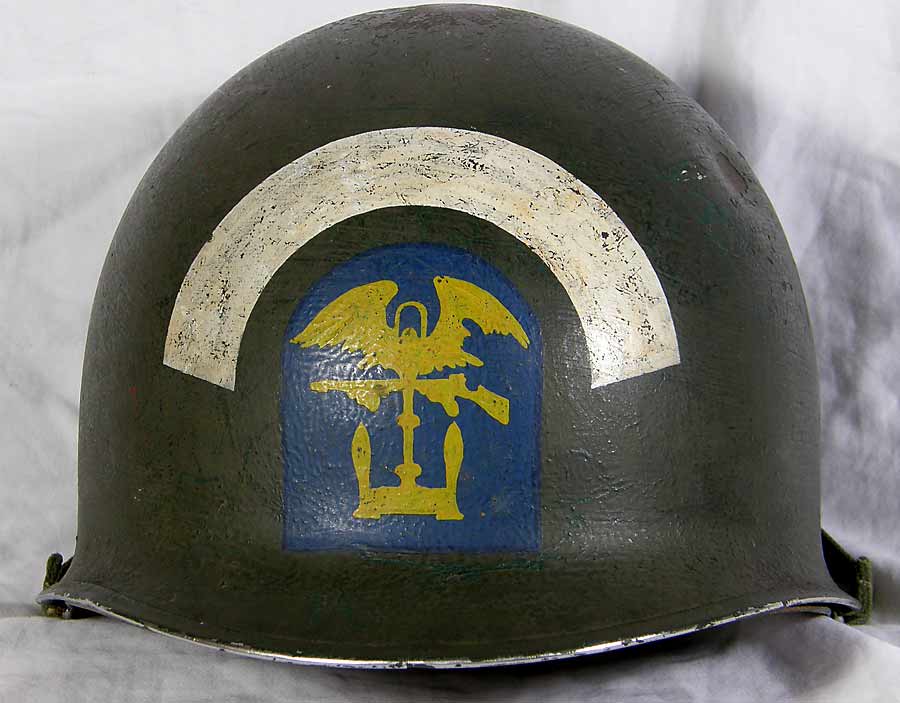
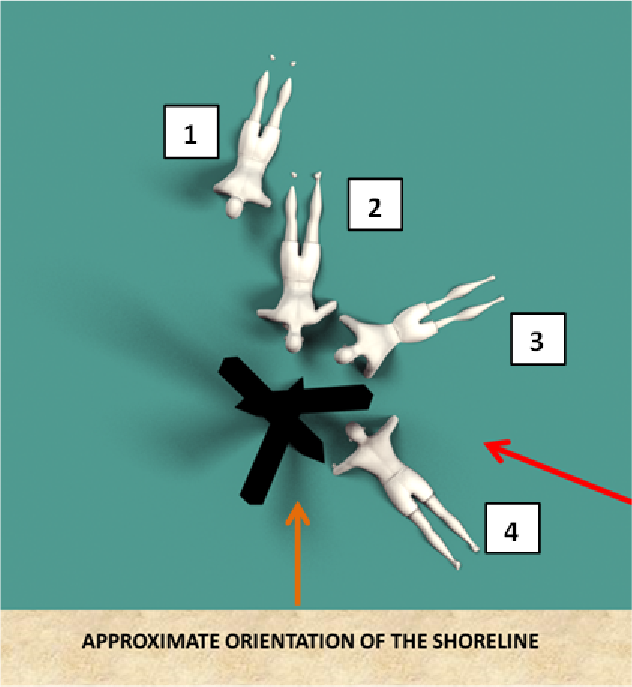

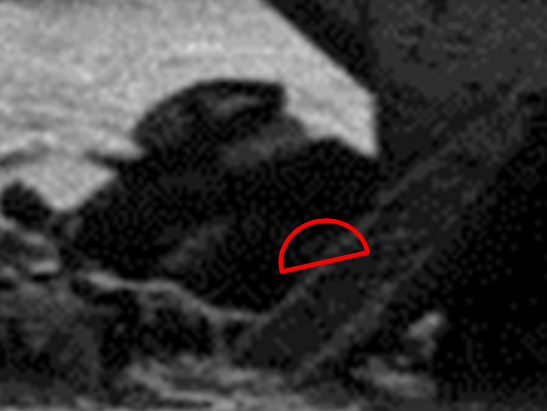
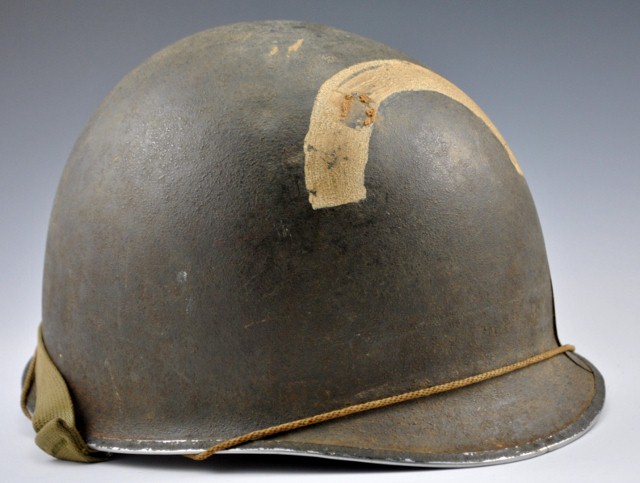
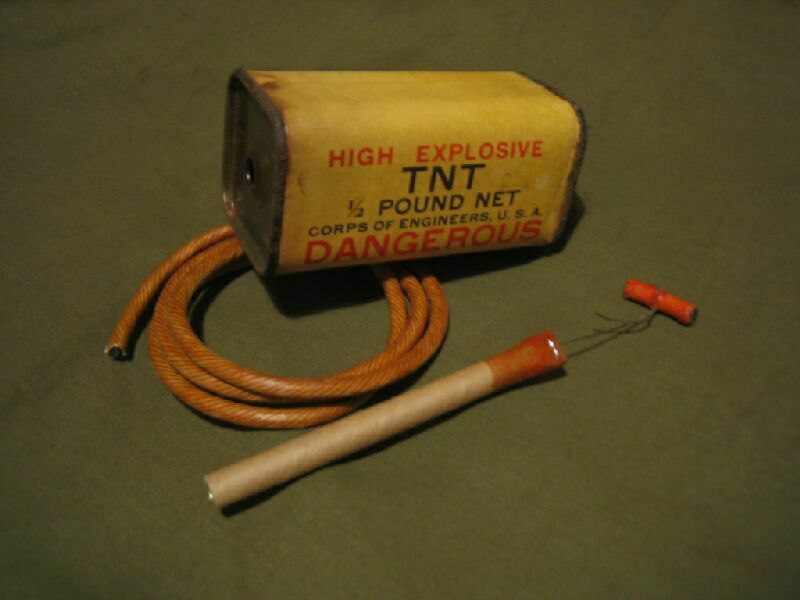
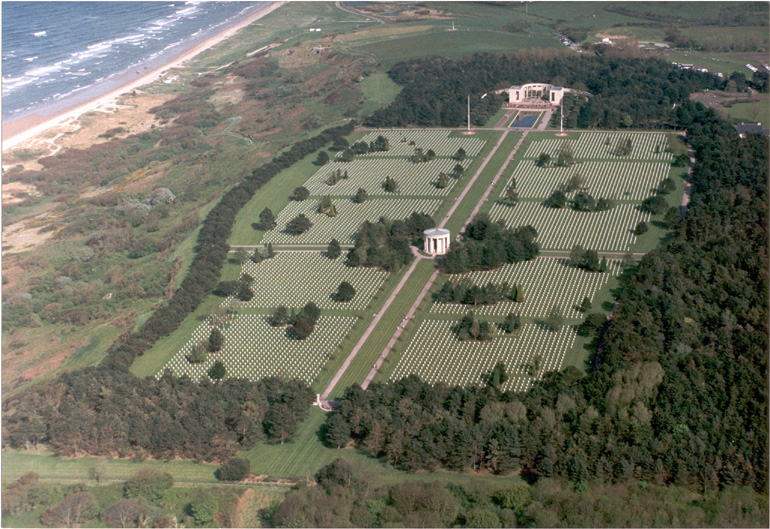
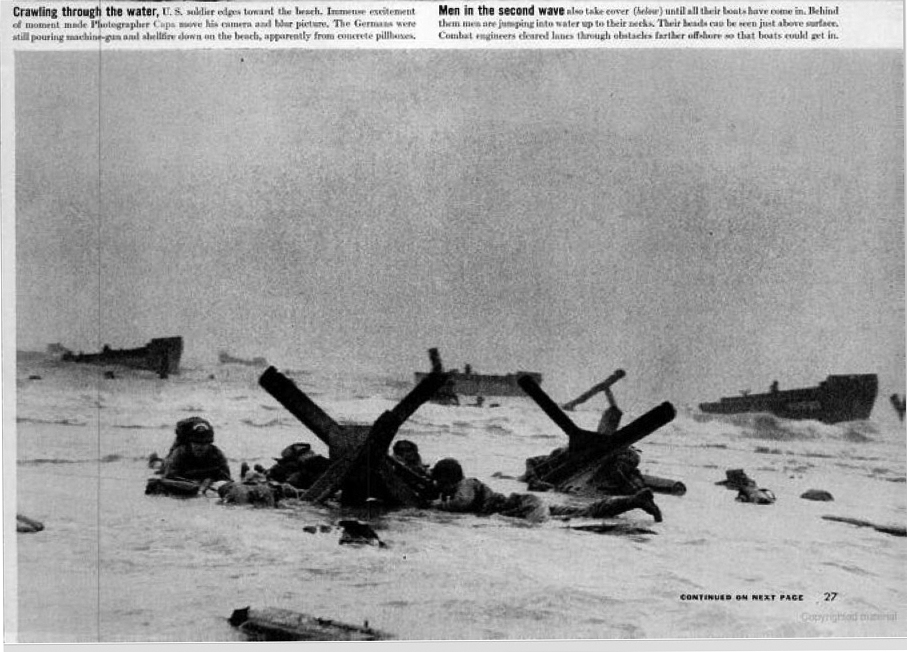
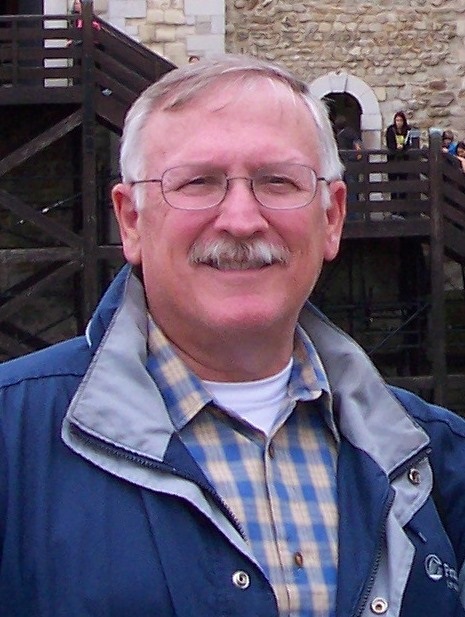




Thanks a lot for this article.
I think however that the “wrong story” (your words) has been coined prior the publication of the Capa’s photographies in Life magazine on June 19, 1944.
You can take a look on my article about the first publications of Capa’s photos in american and canadian newspapers, see here:
http://dejavu.hypotheses.org/1463 (in French)
and on this Flickr pictures set:
https://www.flickr.com/photos/patrickpeccatte/sets/72157635095792349/
In the early publications based on radiophoto, all the captions of the image you analized describe the hedgehogs as shelters, see for example the caption published on Chester Times on June 8, 1944:
https://www.flickr.com/photos/patrickpeccatte/9526505062/
Also, Bernard Lebrun recently discovered what I think to be the first known radiophoto of a Capa’s photo transmitted on June 8, 1944, see:
http://f.hypotheses.org/wp-content/blogs.dir/2287/files/2013/08/radiophoto-Capa-June-8-1944-recto.jpg
The caption of this picture proves that the dramatic interpretation as soldiers under heavy fire has been coined by Morris team in London as soon as June 8, not by Life magazine team on June 19.
While John Morris certainly added captions to the photos by Capa and David Scherman that he sent to LIFE in New York and provided to the press pool, we can’t say for certain that the press pool used those same captions verbatim. The editors at LIFE almost certainly had them rewritten to conform to “house style” and fit in with the accompanying story — standard operating procedure at publications everywhere, then and now.
Perhaps, if TIME/LIFE retained in its files the raw materials for its D-Day issue, and someday either allows a researcher to examine and write about those or produces its own feature story on the making of that issue, we may yet learn what Morris sent them and how that got transformed in the editorial process. Until then, we can state with confidence only that Morris selected the 200-plus images from which LIFE and the press pool made their selection, edited whatever captioning information Scherman sent in, and and provided some basic captioning for the Capa images.
Charles and Allan,
This is phenomenal research. An extraordinary project gets even better.
Best,
Stephen
Absolutely astonishing! It appears to be a huge Freudian slip to have the original captions mirror the photographer’s own state of mind, rather than what was really going on with the soldiers on that beach. Capa surely knew who they were and what they were doing, but failed to inform his editor upon delivery of his film and instead let stand a blatant misinterpretation of his images throughout his career.
Again, is “looking” so hard that “seeing” is so fundamentally flawed? Capa’s negatives bear no physical evidence of the story promulgated about them for 70 years, and the images themselves contain ample proof of heroic efforts under enemy fire which the author here easily authenticates by simply looking AND seeing. FORENSIC EVIDENCE. NYC’s photography curators should be required to attend ‘remedial’ forensics classes at John Jay School of Criminal Justice.
Cheers, Colleen
The estimable Peter Marshall, who has tracked this project from the start at his U.K. blog >Re: PHOTO, has posted a substantial response to this research from Charles Herrick: “Capa’s Story,” datelined June 10. I commend it to you in its entirety. An excerpt:
“As this case demonstrates, [serious criticism] often … needs some specialist knowledge … But in this case, perhaps more than anything else it needs the courage to think out loud the unthinkable, that people and institutions that have been revered for years have been deliberately repeating a lie. Or in this case, perpetuating lies and a mistaken interpretation.”
What did these engineers do after d-day? Two men with the same helmets are in a photo of my grandfather (who was in the 5th ID) visiting Pierrefonds in September ’44?
As Charles Herrick points out in his analysis, “[T]he Combined Demolition Units (CDUs) assembled for D-Day each consisted of about 40 men drawn from both the U.S. Army and the U.S. Navy.” Mostly Army, these 40-man units included 8 Navy personnel, presumably for their expertise in underwater demolition.
Known collectively as the “Engineer Special Task Force,” they were specifically assigned to opening up lanes through which the variously sized invasion vessels could pass.
Although neither Herrick nor I have tracked their actions after D-Day, we know that the Navy engineers undertook many post-D-Day tasks along the coast. It seems logical that the Navy engineers who participated in the initial invasion stayed on the coast, while the Army engineers pushed inland with the troops.
These D-Day squads included only a small portion of the Army and Navy engineers assigned to the European Theater of Operations (ETO). Engineers accompanied all divisions, landing at different times as the land battle developed. All of them wore the same insignias on their helmets. So, while the engineers seen in that photo with your grandfather (made in northern France) may have taken part in the D-Day landing on June 6, it’s more likely that they arrived later.
Capa didn’t caption these images, and neither John Morris in London nor anyone in the New York office of Life recognized these insignias. And until Herrick published this analysis, the exact location at which Capa made these images went unidentified. Thus no one realized they were members of Demolition Unit 10 — the most successful of all these units that day. These brave men most likely never realized that these pictures show them going about their heroic work.
My father is Soldier 1 in the photo. He was a member of the 348th Combat Engineer’s Battalion. Here is a history of the unit’s activities throughout the war:
https://digicom.bpl.lib.me.us/cgi/viewcontent.cgi?article=1031&context=ww_reg_his
For what it is worth, he (Lt. Robert Walsh) and his group’s work after the landing is mentioned in that history on pages 38 and 39.
I’m not sure that anyone could verify (or disprove) a claim as to the identities of any of these men. Capa’s distance from the scene, the low light, the slight blur of the exposure, and the coarse grain of this Super-XX film render their facial features and any identifying insignia unreadable. I have to take any claim of recognition as an article of faith, not a statement of fact.
Jim, my dad too was with the 348th Combat engineers. He was the regimenal dental officer and came in with the medical officer (Capt. Accetolla and 40 medics). They put up the first aid station on Omaha beach along with the first flag to be raised on Omaha beach. I would ove the hear more if you have additional information.
The reason I believe your dad was in the picture is that many of the combat photo’s included many men from the 348th because the photographers came ashore with the 348th.
This is incorrect. The demolition teams came in as part of the second wave, charged with destroying the obstacles so that landing craft could get through. No photographers or other journalists arrived until much later.